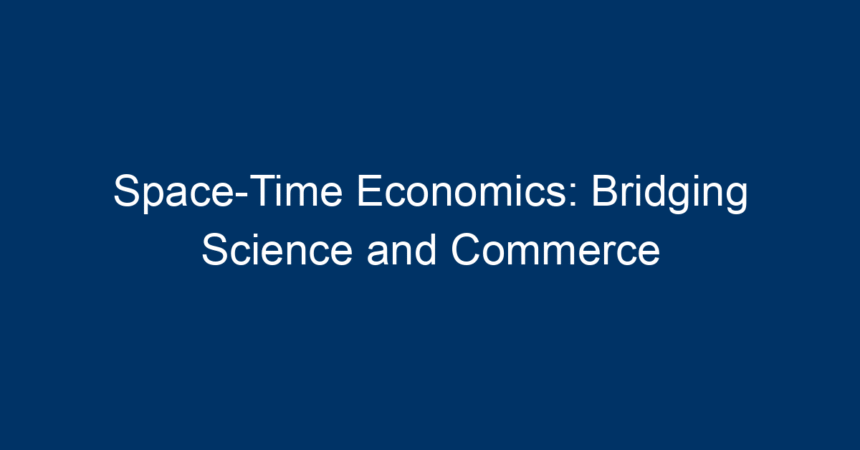Introduction
In an era where technology and innovation shape our everyday lives, the concept of space-time economics emerges as a pivotal junction between science and commerce. This intriguing field delves into how economic interactions are increasingly influenced by the dimensions of space and time, moving beyond traditional economic models. Understanding space-time economics is essential for businesses aiming to thrive in a rapidly evolving marketplace, especially as globalization and digitalization redefine boundaries.
In this article, we will explore the foundational principles of space-time economics, analyze its applications across various sectors, and discuss how businesses can leverage these insights to drive strategic growth.
Understanding Space-Time Economics
What is Space-Time Economics?
At its core, space-time economics is the study of how geographical and temporal variables impact economic activities. While traditional economics emphasizes factors like supply and demand, space-time economics incorporates the spatial and temporal dimensions, recognizing that distance and time affect decision-making, resource allocation, and market dynamics.
This interdisciplinary approach draws from physics, geography, and economics, illustrating how market behaviors are influenced by the physical and temporal distances between entities. Key facets of space-time economics include:
- Geospatial Analysis: Evaluating market behaviors based on geographical data.
- Temporal Dynamics: Investigating how timing affects market trends.
- Network Effects: Understanding how social and business networks influence economics in both space and time.
Theoretical Frameworks
Space-time economics encompasses several theoretical frameworks that help explain economic phenomena:
-
Spatial Economics: Focuses on how the geographic distribution of resources affects economic outcomes. It studies urbanization, regional development, and the location choices of firms.
-
Temporal Economics: Examines the time-related aspects of economics, including how time preferences impact consumer behavior and investment decisions.
- Agent-Based Modeling: Utilizes simulations to model the interactions of individuals or entities across space and time, offering insights into complex economic systems.
These frameworks serve as tools for economists and business strategists alike, providing a richer understanding of market trends and consumer behavior.
Applications of Space-Time Economics
1. Urban Planning and Real Estate Development
In urban planning, space-time economics plays a fundamental role in determining the ideal locations for infrastructure projects and real estate investments. By analyzing spatial data, planners can predict how populations will shift over time, allowing them to optimize resource distribution and services. For instance, understanding traffic patterns and commuter behaviors enables more effective public transport systems.
2. Supply Chain Management
Modern supply chains operate across vast geographic distances and face challenges related to time sensitivity. Space-time economics provides insights into optimizing logistics, ensuring timely deliveries, and reducing costs. By factoring in distance and transportation times, businesses can make informed decisions about inventory management, supplier relationships, and distribution channels.
3. Tourism and Hospitality Sector
The tourism industry heavily relies on space-time economics to develop targeted marketing strategies. Analyzing travel patterns and seasonal demand allows hotels and attractions to customize offerings based on when and where customers are likely to travel. This data-driven approach enhances customer satisfaction and maximizes profitability.
4. E-commerce and Digital Marketing
In the digital realm, space-time economics has transformed the way businesses engage with consumers. Online retailers utilize geolocation data to tailor marketing campaigns and promotions based on a user’s location and the time of access. Understanding these dynamics helps businesses reach potential customers more effectively and increase conversion rates.
Potential Challenges
Data Collection and Analysis
One of the greatest hurdles in leveraging space-time economics is the availability and accuracy of data. Analyzing geographic and temporal data requires sophisticated tools and methodologies. Additionally, companies must ensure they respect consumer privacy and comply with regulations when collecting data.
Complexity in Modeling
Another challenge is the complexity involved in modeling economic interactions across space and time. Effective models must incorporate a multitude of variables, including cultural, social, and economic factors, making them difficult to implement and interpret without the right expertise.
Rapid Technological Advancements
The fast-paced evolution of technology complicates space-time economics. As new tools and platforms emerge, companies must continuously adapt their strategies to remain competitive. Businesses that fail to keep up with these changes risk obsolescence.
Strategies for Integrating Space-Time Economics into Business
1. Invest in Geographic Information Systems (GIS)
Businesses should invest in GIS technology to analyze spatial data effectively. GIS allows companies to visualize data, uncover trends, and make data-driven decisions regarding location-based services and strategies.
2. Adopt Predictive Analytics
Incorporating predictive analytics can enhance understanding of temporal dynamics. By analyzing historical data, businesses can forecast future trends and adjust their strategies accordingly, improving responsiveness and agility.
3. Foster Collaborative Approaches
Encouraging collaboration among various departments—such as marketing, logistics, and finance—can lead to a more cohesive strategy that accounts for both spatial and temporal considerations. This holistic approach ensures that all aspects of the business are aligned with the principles of space-time economics.
4. Embrace Automation and AI
Utilizing automation and artificial intelligence can streamline data analysis and improve business operations. These technologies can help in processing vast amounts of data, enabling more efficient decision-making and better resource allocation.
Conclusion
Space-time economics represents a transformative force in understanding the complexities of modern commerce. By recognizing the interplay between space and time, businesses can make informed decisions that cater to evolving customer needs and market dynamics. From urban planning to e-commerce, the principles of space-time economics can drive strategic advantage and foster growth in an increasingly interconnected world.
For businesses looking to implement space-time economics into their strategies, investing in technology, fostering collaboration, and embracing data-driven decisions are key proactive steps. By doing so, companies not only remain competitive but also position themselves for sustainable success in the ever-evolving landscape of global commerce.
Through the lens of space-time economics, organizations can unlock new opportunities and insights that will help them thrive in today’s complex economic environment.




